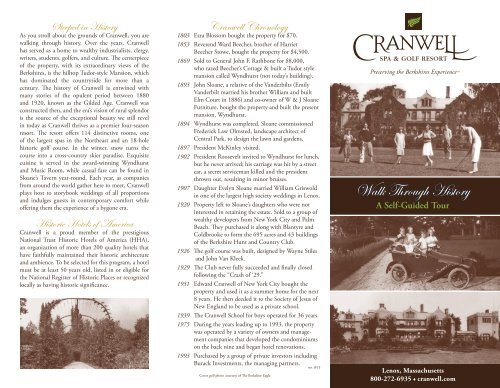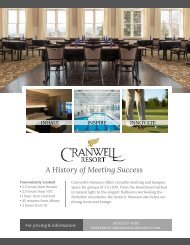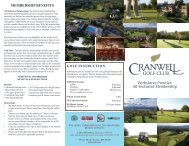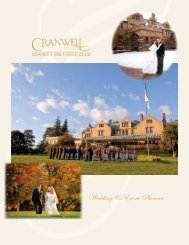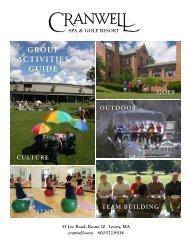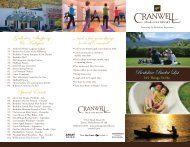Create successful ePaper yourself
Turn your PDF publications into a flip-book with our unique Google optimized e-Paper software.
Steeped in <strong>History</strong><br />
As you stroll about the grounds of <strong>Cranwell</strong>, you are<br />
walking through history. Over the years, <strong>Cranwell</strong><br />
has served as a home to wealthy industrialists, clergy,<br />
writers, students, golfers, and culture. The centerpiece<br />
of the property, with its extraordinary views of the<br />
Berkshires, is the hilltop Tudor-style Mansion, which<br />
has dominated the countryside for more than a<br />
century. The history of <strong>Cranwell</strong> is entwined with<br />
many stories of the opulent period between 1880<br />
and 1920, known as the Gilded Age. <strong>Cranwell</strong> was<br />
constructed then, and the era’s vision of rural splendor<br />
is the source of the exceptional beauty we still revel<br />
in today as <strong>Cranwell</strong> thrives as a premier four-season<br />
resort. The resort offers 114 distinctive rooms, one<br />
of the largest spas in the Northeast and an 18-hole<br />
historic golf course. In the winter, snow turns the<br />
course into a cross-country skier paradise. Exquisite<br />
cuisine is served in the award-winning Wyndhurst<br />
and Music Room, while casual fare can be found in<br />
Sloane’s Tavern year-round. Each year, as companies<br />
from around the world gather here to meet, <strong>Cranwell</strong><br />
plays host to storybook weddings of all proportions<br />
and indulges guests in contemporary comfort while<br />
offering them the experience of a bygone era.<br />
Historic Hotels of America<br />
<strong>Cranwell</strong> is a proud member of the prestigious<br />
National Trust Historic Hotels of America (HHA),<br />
an organization of more than 200 quality hotels that<br />
have faithfully maintained their historic architecture<br />
and ambience. To be selected for this program, a hotel<br />
must be at least 50 years old, listed in or eligible for<br />
the National Register of Historic Places or recognized<br />
locally as having historic significance.<br />
<strong>Cranwell</strong> Chronology<br />
1803 Ezra Blossom bought the property for $70.<br />
1853 Reverend Ward Beecher, brother of Harriet<br />
Beecher Stowe, bought the property for $4,500.<br />
1869 Sold to General John F. Rathbone for $8,000,<br />
who razed Beecher’s Cottage & built a Tudor style<br />
mansion called Wyndhurst (not today’s building).<br />
1893 John Sloane, a relative of the Vanderbilts (Emily<br />
Vanderbilt married his brother William and built<br />
Elm Court in 1886) and co-owner of W & J Sloane<br />
Furniture, bought the property and built the present<br />
mansion, Wyndhurst.<br />
1894 Wyndhurst was completed. Sloane commissioned<br />
Frederick Law Olmsted, landscape architect of<br />
Central Park, to design the lawn and gardens.<br />
1897 President McKinley visited.<br />
1902 President Roosevelt invited to Wyndhurst for lunch,<br />
but he never arrived; his carriage was hit by a street<br />
car, a secret serviceman killed and the president<br />
thrown out, resulting in minor bruises.<br />
1907 Daughter Evelyn Sloane married William Griswold<br />
in one of the largest high society weddings in Lenox.<br />
1920 Property left to Sloane’s daughters who were not<br />
interested in retaining the estate. Sold to a group of<br />
wealthy developers from New York City and Palm<br />
Beach. They purchased it along with Blantyre and<br />
Coldbrooke to form the 695 acres and 43 buildings<br />
of the Berkshire Hunt and Country Club.<br />
1926 The golf course was built, designed by Wayne Stiles<br />
and John Van Kleek.<br />
1929 The Club never fully succeeded and finally closed<br />
following the “Crash of ‘29.”<br />
1931 Edward <strong>Cranwell</strong> of New York City bought the<br />
property and used it as a summer home for the next<br />
8 years. He then deeded it to the Society of Jesus of<br />
New England to be used as a private school.<br />
1939 The <strong>Cranwell</strong> School for boys operated for 36 years.<br />
1975 During the years leading up to 1993, the property<br />
was operated by a variety of owners and management<br />
companies that developed the condominiums<br />
on the back nine and began hotel renovations.<br />
1993 Purchased by a group of private investors including<br />
Burack Investments, the managing partners.<br />
Cover golf photo courtesy of The Berkshire Eagle<br />
rev. 8/15<br />
Preserving the Berkshires Experience <br />
Walk Through <strong>History</strong><br />
A Self-Guided Tour<br />
Lenox, Massachusetts<br />
800-272-6935 cranwell.com
The Mansion<br />
Early 1900s Lenox became known as the “Inland<br />
Newport” and at least 42 millionaires were known to<br />
spend their summers here during this time, including<br />
John Sloane, a relative of the Vanderbilts and co-owner<br />
of the famous furniture firm W & J Sloane. He bought<br />
the property for $50,000 and in 1894 built his Peabody<br />
and Sterns-designed “cottage” Wyndhurst, referred to<br />
today as the Mansion. This was known as the “Cottage<br />
Era” where cottages were defined as a secondary<br />
residence with a minimum of 30 rooms and 20 acres.<br />
Presidential Visit<br />
President McKinley visited Wyndhurst with his wife<br />
on September 25, 1897. He was a close friend of<br />
John Sloane’s until his death in 1901. To impress the<br />
Presidential party during dinner, a large centerpiece<br />
of an American Eagle surrounded by roses was<br />
mechanically lit up and brought to life. Mrs. McKinley<br />
was startled and so visibly upset that she had to be<br />
escorted from the room by her husband.<br />
Lobby & Music Room<br />
As you enter the Mansion Lobby, notice the oak panels<br />
and red leather inserts between the ceiling beams. The<br />
fireplace to your left is one of only two still-working<br />
fireplaces at <strong>Cranwell</strong>. The white Cortina marble fireplace<br />
in the adjoining Music Room is another example of the<br />
variety and intricacy of the 15 fireplaces in this “cottage.”<br />
Carved into the woodwork of the Music Room Lounge<br />
fireplace is the year Wyndhurst was built.<br />
Wyndhurst Dining Room<br />
To the right of the Lobby is the Wyndhurst Dining Room.<br />
The White House Blue Room ceiling was modeled after<br />
this room’s ceiling pattern when W & J Sloane Co. was<br />
commissioned for work at the White House.<br />
Rose Terrace<br />
“From here I can see the very hills of Heaven,”<br />
proclaimed the Reverend Henry Ward Beecher, a<br />
popular preacher active in the women’s suffrage and<br />
abolitionist movements. In 1853 he purchased Blossom<br />
Hill, where the Mansion now stands, for $4,500. The<br />
views he loved are the same that can be seen today when<br />
you sit on the Rose Terrace off of the Lobby and are<br />
reminded of the legendary parties that took place on this<br />
same hillside over 150 years ago. Ward Beecher’s sister<br />
Harriet Beecher Stowe, author of Uncle Tom’s Cabin,<br />
and fellow writer Nathaniel Hawthorne were frequent<br />
visitors at this time. Civil War General John Rathbone<br />
was the next owner of the property and built a mansion<br />
on this hill in 1869 named Wyndhurst. The building<br />
was razed but the name remains. Rathbone owned a<br />
prosperous stove works foundry that eventually became<br />
the biggest in the world. He was also a philanthropist<br />
who is credited with bringing the first computer to the<br />
U.S. in 1855. Views from the hill: October Mountain<br />
(East), Laurel Lake (South), Lenox Mountain and the<br />
Taconic Range (West), Mt. Greylock (23 miles North).<br />
Mansion Ballroom<br />
Follow the signs down the hallway to the Ballroom,<br />
which was added in 1949 as a dining hall for the<br />
<strong>Cranwell</strong> School for Boys. In 2013 this 3,025 squarefoot<br />
ballroom was completely renovated with dramatic<br />
columns of drapery framing the 12-foot windows<br />
and chandeliers adorned with strings of crystals to<br />
complement the 16-foot ceiling.<br />
Carriage House<br />
A short walk from the Mansion, the 18-room Carriage<br />
House was opened in July 2012 to replace the structure<br />
that was destroyed by fire in December 2010. The<br />
new building design respects the historic nature of the<br />
property bringing back much of the glory of the circa<br />
1890s structure, which served as the Carriage House<br />
for Wyndhurst. The original architectural drawings by<br />
Peabody and Stearns Architects were located in the Boston<br />
Public Library and used to help design the guest<br />
space, incorporating many concepts from the original<br />
building, such as the tower, cantilevered floors at the<br />
upper level, as well as roof lines and gables, to create a<br />
new design that still respects the original structure.<br />
Beecher’s<br />
A walk past the practice putting green brings you<br />
to the oldest building on property. In 1882, United<br />
States Naval Captain John S. Barnes, Flag Officer<br />
of the North Atlantic Fleet during the Civil War,<br />
purchased the land next to Wyndhurst for $10,000<br />
and erected Coldbrooke, now known as Beecher’s.<br />
This Queen Anne-style shingled house with a central<br />
gable was designed by Peabody and Sterns and is<br />
located near the 1st tee of the golf course.<br />
Golf Course<br />
This magnificent 18-hole golf course was built by<br />
Wayne Stiles and John Van Kleek in 1926 on the<br />
site of the original Berkshire Hunt Club. They also<br />
designed the Taconic Course in Williamstown and the<br />
Wahconah Golf Club in Dalton. Magnificent views,<br />
tree-lined fairways and naturally-contoured greens<br />
have been carefully preserved.<br />
Olmsted Manor & Founders<br />
Take a stroll to Olmsted Manor and then through<br />
the enclosed walkway to Founders. Both buildings<br />
have been completely renovated (in 2000 and 1997<br />
respectively) but originate from <strong>Cranwell</strong>’s time as<br />
a preparatory school. In 1939, Edward <strong>Cranwell</strong><br />
deeded the property to the New England Province of<br />
the Society of Jesus, which operated a private school<br />
for boys here until 1975. Ted Kennedy attended his<br />
8th grade at <strong>Cranwell</strong> in 1945. Leonard Bernstein<br />
roomed with four other student musicians studying<br />
under Serge Koussevitzky at the BSO Tanglewood<br />
Music School. Olmsted Manor was a student resident<br />
hall, originally named Bellarmine Hall, after Cardinal<br />
Bellarmine, and built in 1957. Founders was built in<br />
1963 as an additional resident hall.


